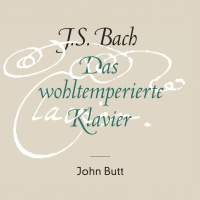Texte paru dans: / Appeared in: |
|
|
Outil de traduction (Très approximatif) |
|
|
|
|
|
Reviewer: Jerry
Dubins It seems a shame to submit such a short review for a set of Bach’s complete Well-Tempered Clavier (appearing in physical media on 4 CDs), but for once, I can’t find much to say. I gave a strong “recommended” to John Butt’s Handel’s Esther in 36:2, and an equally strong “not recommended” to his Bach’s Brandenburg Concertos in 37:4. Both of those recordings were with Butt’s Dunedin Consort. Here he is on his own, and my reactions are mixed. On the plus side, Butt plays one of the most attractive sounding harpsichords I’ve heard. It has a full-bodied, unwavering tone and a non-“plucky” mechanism that make extended listening a pleasure instead of a fatiguing chore. Built by Bruce Kennedy, the instrument is a copy of a circa 1702 harpsichord by German maker Michael Mietke, owned by the Dunedin Consort and tuned here to A=415 Hz. I won’t say “on the negative side” because Butt’s playing of the 48 Preludes and Fugues is not in any way flawed from a technical perspective; rather, it’s his interpretive approach that raises questions and that may be seen as controversial. Butt’s lengthy album note delves into a great deal of esoteric detail, drawing upon musicological sources both historical and recent regarding tempo and rhythmic relationships within and between the prelude and fugue pairs. His line of discourse is that Bach intended certain reciprocal correspondences in tempos, such as 1:2, 2:1, and so on, between many of the coupled twosomes. For example, given a prelude of 60 bars in 6/8 and its paired fugue of 120 bars in 3/8, if played in the same Takt, the two should be of exactly equal duration. This is just one of the relational concordances Butt discusses; others are more mathematically complicated, and all are conjectural, for it seems to me that much of this is brought into question by the fact that many of the preludes and fugues were composed as stand-alone, unrelated pieces well before being united in The Well-Tempered Clavier. Did Bach really go to the trouble of combing through his manuscript sheaths to find a prelude here to put together with a fugue there that satisfied these tempo and rhythmic relationships? And let’s say he did, but what if the prelude he found that went together with a particular fugue was in F Major, while the fugue was in G Minor. Then what? One can always find symbolic meaning in the mathematics of music, especially in the music of a composer like Bach, who really did take numerology seriously. But caution is urged when it comes to imputing our own arbitrary findings to the composer’s intent. In applying these theories to practice, Butt makes some unusual tempo choices and engages in other interpretive mannerisms that listeners may find a bit unnerving. Right off the bat, for example, he introduces an odd hiccup into the rhythmic regularity of the C-Major Prelude from Book I, pausing slightly on the top 16th-note (the fifth note) in each group of eight 16ths. Nor is he consistent about it; every third or fourth bar he decides to play the 16ths straight. I suppose Butt’s purpose is to make his reading of the piece sound freer and more toccata-like, which it does, but it also sounds gimpy and impedes the harmonic rhythm—i.e., the changing of the chords—as opposed to the metric rhythm. There’s also little sense of tempo regularity and rhythmic steadiness in the fugues, where it often seems—though I’m sure it’s not the case—that Butt slows down when the going gets tough, and then rushes forward precipitously when the difficulties pass. Rather, let’s just say that he’s a strong proponent of rubato.
John Butt
is a highly informed and intelligent musician, and I’m sure he thought long
and hard about this monumental undertaking. Therefore, I’m not inclined to
reject his effort out of hand. I am inclined, however, to say that his
Well-Tempered Clavier might make an interesting addition to more
conventional harpsichord versions by Ralph Kirkpatrick and Blandine Verlet.
Perusing the current listings, it surprises me to find how many more
versions of the WTC there are on piano than there are on harpsichord, so if
your preference is for piano, you have a wider range of choices. | |
|
|
|
|
Cliquez l'un ou l'autre
bouton pour découvrir bien d'autres critiques de CD |
|




